Bicentennial Solar Pavilion for the Arts,
Minnesota State Fairgrounds, St.Paul, Minnesota, 1975
January 19, 1976
Architect's Brief:
A Proposal for the Bicentennial Solar Pavilion for the Arts
For the Minnesota State Agricultural Society
Dennis R. Holloway, Architect
INTRODUCTION:
This report presents the work to date on the design for a New Solar Pavilion for the Arts commissioned by the Minnesota State Agricultural Society to be built on the historic grounds of the Minnesota State Fair.
It is our attempt in this proposed design to express a new spirit of our times and to give a glimpse into our future—into the third century.
This new building will educate large numbers of Minnesotans about the possibilities of solar energy utilization and energy conservation, it will focus new attention on the Fairgrounds, and it will become a major new center for Minnesota's creative artists and artisans.
SITE REQUIREMENTS:
Preliminary investigations revealed five potential sites for the Solar Pavilion for the Arts. Criteria for site selection included the following:
• No shade from nearby buildings. Because the proposed building is to be powered by solar energy systems, optimization of income energy is a high priority.
• High ground with dry subsurface. Because the proposed building will depend upon high temperature underground solar storage systems, wet subsurface conditions were considered highly undesirable. A subsurface investigation for Block 25 was performed by Soil Exploration Company and revealed conditions very favorable for the proposes storage system. Block 25 on the map is labeled "A".
• High site visibility and strong visual character. Because the proposed building will be a major architectural landmark for the State Fair Grounds, the selected site should in possess strong existing visual characteristics.
Site A (Block 25) was selected as the site most fit for the Solar Pavilion. It is highly visible on the top of Machinery Hill, bounded to the east and west by Cosgrove and Cooper Streets, major pedestrian access streets to the Hill, and good proximity to the 4H Building and related Art-in-the-Park activities. Block 25 of all the sites considered has the best developed visual qualities, containing many trees and a sense of 'place'. The Solar Pavilion on this site will be dramatically visible from the Grandstand, Snelling Avenue and from the Fairground's central corridor, Commonwealth Avenue. Interestingly, the Space Tower is on the axis of Block 25, two blocks to the south. The 'technology image' environment of Machinery Hill is a fitting setting for the New Solar Pavilion for the Arts.
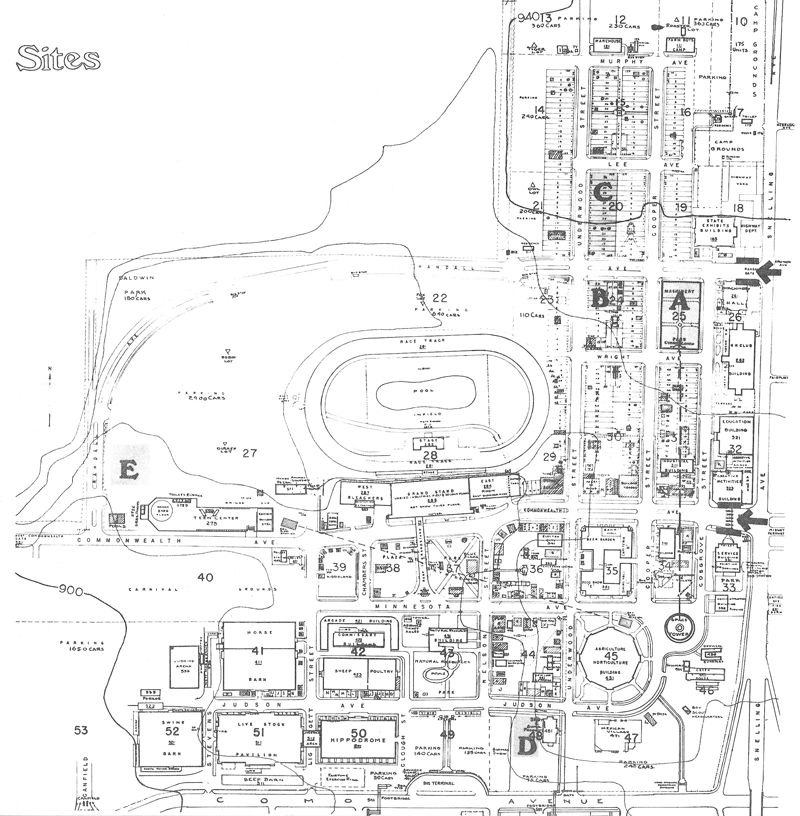
THE PAVILION PLAN
Elements of the Pavilion plan consist of:
• Exhibition/Performance Hall
• Entrance Lobby
• Restrooms
• Kitchen
• Workroom and Exhibit Preparation
• Mechanical Room under Lobby with Public 'Systems Observation' Gallery.
Earth removed during construction of an underfloor solar storage volume is employed in the final construction as a perimeter insulating earth berm that covers a ten foot high perimeter wall of the Pavilion, and also used for grading a performance space to the south of the Pavilion.
In essence the concept of the building is the ancient symbol of the coinciding circle and square. The circle represents a feminine heaven and the square represents a masculine earth. Combined, they represent harmony.
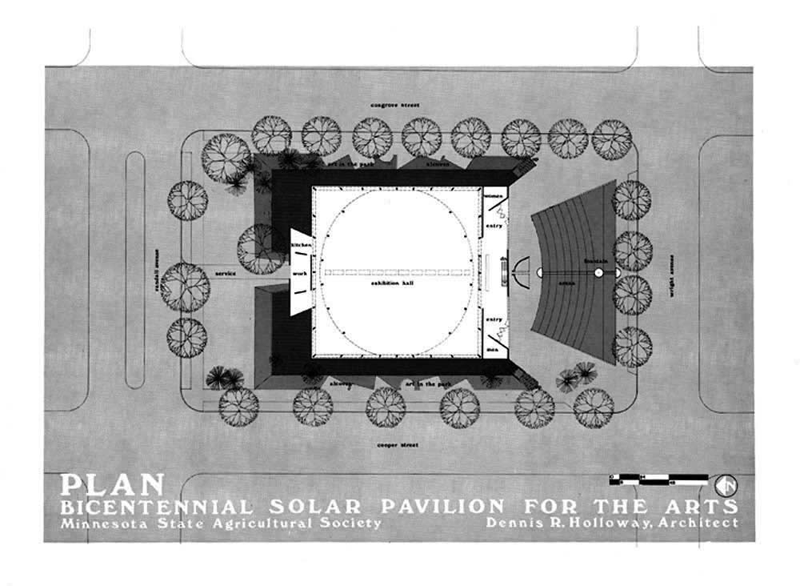
The plan of the exhibition hall is a square, 140 feet on all sides.
Superimposed over this square plan is the circular 'tensegrity catenary truss lens' supporting the south-sloping array of concentrating solar mirrors on the roof above. The circular edge beam of the roof is supported by columns resulting in a clear-span Exhibition/Performance Hall with a diameter of 136 feet (41.45 meters). The perimeter of the square hall consists of a series of exhibit alcoves illuminated by a continuous skylight above.
Although this proposal places the Solar Pavilion for the Arts on one of the open parks of the State Fair Grounds, most of the site in the plan is useable in ways similar to its present use. A significant portion of the site to the north of the Pavilion retains its park-like character. The proposed perimeter earth berms on the east and west sides of the Pavilion are covered with native ground cover and contain 'Art-in-the-Park' alcoves under moveable awning shades; thus, both Cosgrove and Cooper Streets take on a new pedestrian shopping character. The Arena/amphitheater to the south of the Pavilion also serve as open park with generous planting, and as an exhibition space.
Together, the Pavilion and its perimeter site are conceived and designed to accommodate a wide range of artistic exhibition and performance activities, ranging from fine art exhibitions, visual art exhibitions, music and dance performances, conferences, lectures, films and other events. Exhibition and seating systems will be designed for movability and flexibility. Audiences ranging from 200 to 1500 can be contained in the Hall.
THE SECTION THROUGH THE PAVILION
A 13,500 square foot (1254 square meter) array of Sheldahl Corporation concentrating mirror solar collectors, called the 'SLATS', cover the circular roof . To optimize the summer collection of solar energy the rood is tilted at a 20 degree slope, with the highest side to the north. The Exhibition Hall below is thereby provided with a flexible ceiling height ranging from 12 feet to 55 feet (3.6 meters to 16.76 meters).
The roof of the entrance lobby is a public observation Gallery accessible by stairs and ramps to the east and west. From the Gallery the public will be able to closely observe the array of solar concentrators.
Below the floor of the Exhibition Hall is the 'Annual Cycle Energy Storage System' designed by Professor Perry Blackshear, of the University of Minnesota Institute of Technology.
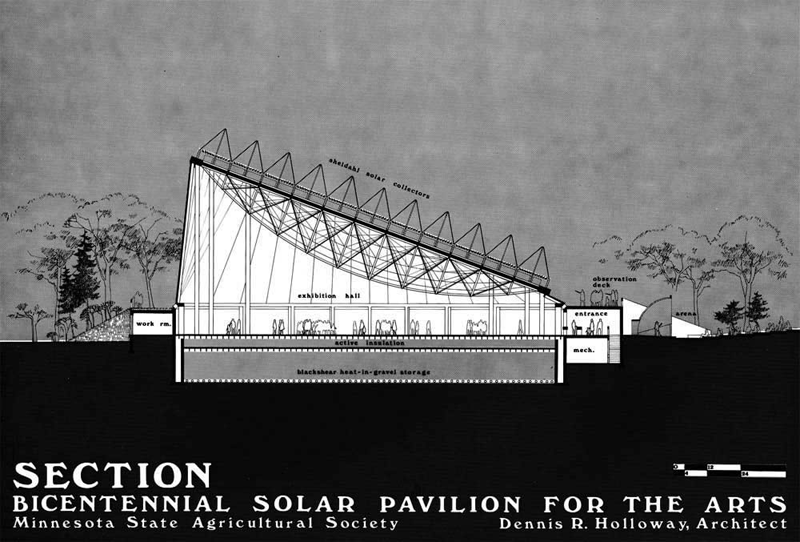
THE ANNUAL CYCLE ENERGY SYSTEM
Because the proposed Solar Pavilion for the Arts is planned for twelve month operation, a mechanical backup system is required. Recently developments in the solar energy research and development field have shown the real potential of wide-spread implementation of captures solar energy as an energy source alternative to fossil fuels.
After investigation a number of alternative solar energy systems, the Sheldahl SLATS system was carefully studied. SLATS system, now its second year of successful testing in Northfield, Minnesota, may prove to be one of the most important solar collecting devices.
Simultaneously, Dr Perry L. Blackshear, Professor of Mechanical Engineering at the University of Minnesota Institute of Technology has developed a revolutionary and unique system for storing high temperature solar energy, which is what the SLAT system produces.
In combination these two systems have the capacity to collect and store summer solar energy for both summer and winter utilization. Effectively, they can provide 100% of the space heating and cooling, plus electric power requirements of the Pavilion.
Now design and systems integration study will commence during the next phase of architectural development.
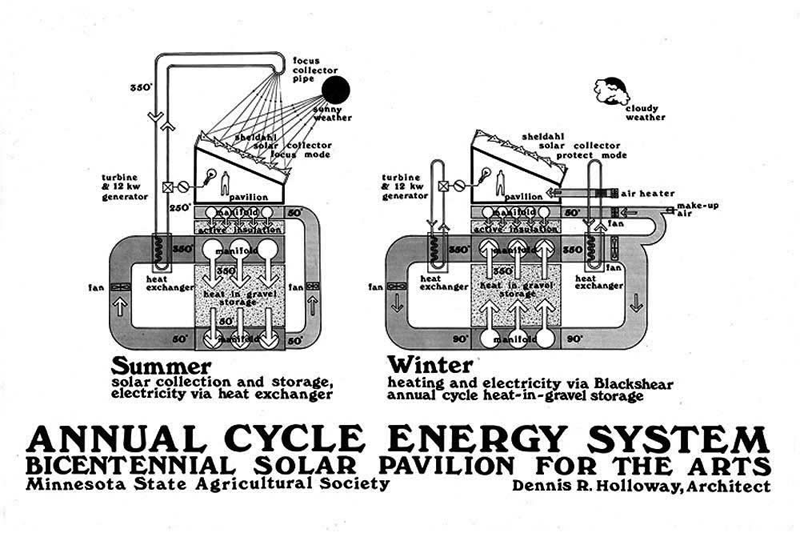
During clear weather solar energy is collected, reflected and focused on the collector pipe, heating the water in the pipe to 350 degrees F. In the basement mechanical room, the water gives its heat to a forced-air heat exchanger. The air, heated to 350 degrees F., is forced through 10 feet (3 meters) of glacial till (gravel) in the Blackshear Annual Cycle Thermal Energy Storage System (ACTES). Solar energy, collected in the summertime is thus stored for winter and summer use.
50 degrees F air is drawn off the bottom of the gravel storage and then forced through 3 feet (1meter) of 'active insulation' gravel directly under the Pavilion floor slab. Three feet of gravel treated in this manner has the insulative value equal to 60 feet of gravel without forced air, and prevents the high temperature, being stored below, from rising into the floor of the Exhibition Hall.
250 degree F water returning to the rooftop concentrating collectors drives a turbine and 12 Kw generator for the Pavilion electrical load.
Three air-conditioning systems are presently being studied for cost effectiveness, and the optimum system will be selected during the next phase of architectural development:
1. Absorption Cycle System: this system uses heat from solar storage to provide cooling. An additional 2000 square feet of collector is required.
2. Ice Bank Annual Cycle Energy System: A tank of water is frozen during the winter to provide summer cooling.
3. Electric Air Conditioning from Solar Income: Electric generators driven by steam from solar storage operates air conditioners at night to cool a water tank; during the day the air conditioners use the cool water to provide cooled air to the Pavilion space.
During overcast weather the air flow in the storage system is reversed; energy stored in the heated gravel is drawn upwards to heat exchangers for production of electricity and heating of the Pavilion's air. 50 degree F air tempered by fresh air make-up continues to actively insulate the Hall floor from the high temperature of the ACTES system.
PROTOTYPE SOLAR BUILDING FORM ANALYSIS
The diagram compares the proposed Solar Pavilion (Prototype II) with other solar building forms employing 'flat plate' solar collectors. The main mechanical advantages of the proposed Pavilion form over the other prototypes results from moderate building volume with wide range of ceiling height, comparatively smaller surface area, low As/V and As/Ap ratios, large collector area, and high Ac/As ratio.
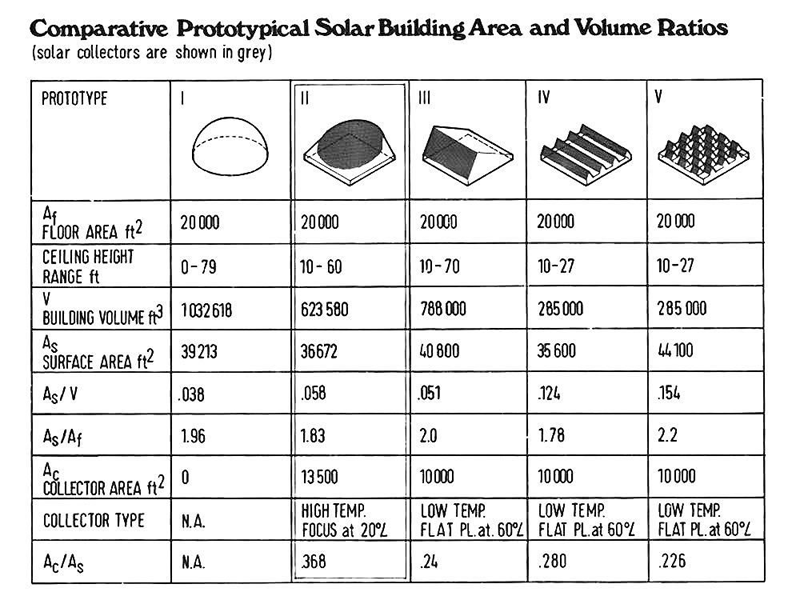
ADDITIONAL REPORTS SUPPLEMENTAL TO THIS BRIEF:
APPENDIX A:
DR. PERRY L. BLACKSHEAR,
University of Minnesota, Institute of Technology
ACTES: A simple economic solar thermal storage system capable of storing excess solar energy from the summer months for use in Minnesota's winter.
APPENDIX B:
DR. DONALD E. ANDERSON
Sheldahl Advanced Products Division
SLATS: Computer analysis determination of expected solar energy including weather considerations for the Solar Pavilion.
